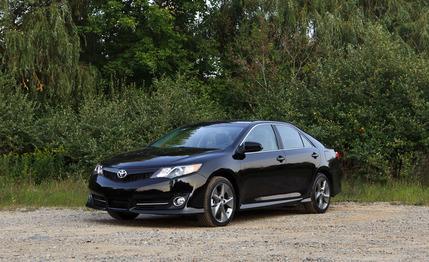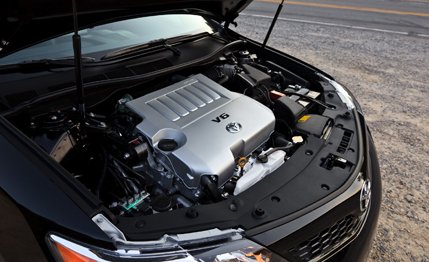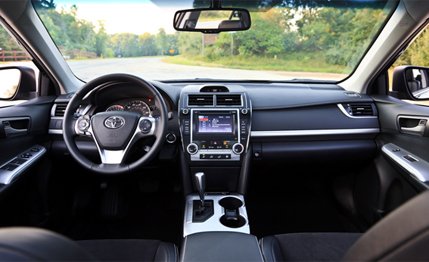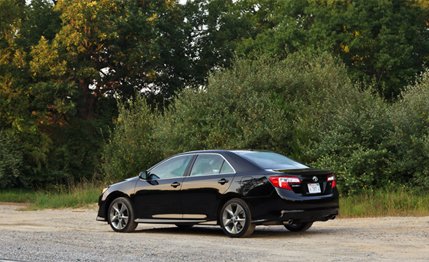
 Short Take Road Test
Short Take Road Test


Like the late Rodney Dangerfield, the Toyota Camry could reasonably complain that it don’t get no respect.
Never mind that it’s been America’s bestselling passenger car in 13 of the past 14 years—the past nine consecutively—and appears to be headed for another sales title this year. Never mind that a financial or marketing exec might observe that those numbers are the only kind of respect that really matters. The Camry don’t get no respect at Car and Driver, and it has only rarely elsewhere over that entire run. But the 2012 Camry, due in showrooms in October, could end—or at least moderate—our disdain.
All-New, Selectively
This is the Camry’s seventh generation—the first appeared in 1983—and inevitably the words “all-new” appear in the accompanying publicity materials. As usual, that description is open to interpretation and/or explanation. Considered in terms of the specifications, all-new is hard to see here. The body dimensions are identical to those of the gen-six car. So are the particulars of the 3.5-liter DOHC 24-valve V-6 that towed our SE test car—same bore, same stroke, same port fuel injection (no direct injection yet), same output: 268 hp, 248 lb-ft of torque.
The only powertrain changes, aimed at improving fuel economy, are subtle: lower-viscosity engine oil (0W-20 versus 5W-30), a transmission-oil warmer to achieve operating temps a little faster, and a higher (numerically lower) final-drive ratio of 3.46:1 versus 3.69:1. The net, according to the EPA, is a gain of 1 mpg in city and highway modes, for a rating of 21/30. We averaged 25 mpg.


New Where It Counts
Although changes to the basic unibody are mostly cosmetic—the seventh-generation sheetmetal, although not exactly head turning, looks contemporary and continues to be commendably slick with a 0.28 Cd—the really significant newness lies within. Without altering exterior dimensions, Toyota’s design team rearranged the Camry’s furniture to create more space for folks inhabiting the rear seats. Key elements: The accelerator pedal and the front-seat rails have sneaked slightly forward, and the backs of the front seats have been scooped out, yielding a rear-seat knee-room gain of 1.8 inches, according to the company.
Expanded roominess is always welcome in a family sedan, and in the new Camry, it’s enhanced by a center rear position that’s habitable for more than a run to the mall. Even more welcome, though, is the upgrade in the materials, including lots of soft-touch surfaces that give the interior an aura of comfort and quality distinctly absent in the last couple generations. The pseudo-suede center inserts in our test car’s optional leather-trimmed front buckets lend a soupçon of luxury, as well as a little grip to keep the driver centered in rapid transitions (not that many of those are likely), and slimmer A-pillar trim yields better forward sightlines.
Hold the Excitement
Assessed as a device with which to satisfy your inner Sebastian Vettel, the new Camry is pretty similar to its predecessor, which is to say essentially bland. Our test car was an SE model, nominally sportier than the rest of the lineup, but the suspension tuning is still skewed strongly toward the comfort side of the chart. There’s considerable body roll in hard cornering, obstinate understeer progresses to absolute, and as is common nowadays, a new electric-assist power-steering system substitutes weight for tactile information. This string of criticisms would add up to “fuhgedaboudit” if the Camry had sports-sedan pretensions. But it doesn’t, and its dynamic virtues are on target for its family-sedan mission.


And let us not neglect the power component. The Camry’s optional V-6 may be basically unchanged, but it delivers respectable hustle—0 to 60 mph in 5.8 seconds, the quarter-mile in 14.3 at 101 mph, 50 to 70 in 3.7. Those times are brisk for this class and would have been tops in our recent sedan comparison involving the Honda Accord EX-L V-6, Hyundai Sonata 2.0T Limited, and Volkswagen Passat 3.6 SEL. Chalk it up in part to a curb weight—3407 pounds—100 pounds wispier than that of the lightest car in that group. Similarly, our test Camry’s 0.83-g skidpad performance would have topped those charts, and its 70-to-0-mph braking distance—173 feet—would have been 15 feet better than the comparo’s best stopper.
Respectability Returns
All in all, what Toyota has achieved with the latest Camry makeover is a return to the traits that put this car at the top of so many families’ shopping lists. An aggressive pricing schedule can’t hurt, either. The base price for most models is down versus 2011’s by as much as 7.5 percent, and the base for our test car—$27,400, less than any of the comparo trio previously cited—is unchanged from the previous generation.
Although well equipped in basic trim, our SE had a substantial inventory of optional equipment: the Leather package (seats, door trim, heated front seats, $1050); a power sunroof ($915); and navigation with Entune, Toyota’s infotainment system ($1550). The latter package also included a rearview camera, an auto-dimming rearview mirror with digital compass, an anti-theft alarm, and JBL audio with Bluetooth and voice recognition. The nav system is one of the most cooperative we’ve ever encountered, and we were similarly pleased with the JBL audio system. The bottom line as tested: $30,935.
This still isn’t the kind of car that raises pulse rates. But it is competent in everything, just right for a driver who doesn’t want to be involved any more than is absolutely necessary. As the Camry’s phenomenal sales record shows, there are a lot of those drivers out there. The new Camry should make them happier than they’ve been in a long time.

